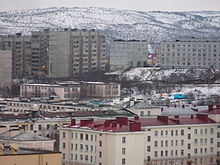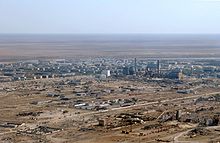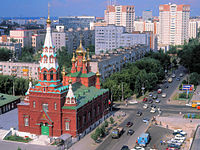Closed city


A closed city or closed town is a settlement where travel or residency restrictions are applied so that specific authorization is required to visit or remain overnight.
They may be sensitive military establishments or secret research installations which require much more space or freedom than is available in a conventional military base. There may also be a wider variety of permanent residents including close family members of workers or trusted traders who are not directly connected with its clandestine purposes.
Closed cities are a feature of heavily militarized countries and secretive regimes[example needed], and many still exist in the successor countries to the Soviet Union. In modern Russia, such places are officially known as "closed administrative-territorial formations" (закрытые административно-территориальные образования, zakrytye administrativno-territorial'nye obrazovaniya, or ЗАТО ZATO for short).
Structure and operations

Sometimes closed cities may only be represented on classified maps which are not available to the general public. In some cases there may be no road signs or directions to closed cities, and they are usually omitted from railroad time tables and bus routes.
Sometimes closed cities may be indicated obliquely as a nearby insignificant village, with the name of the stop serving the closed city made equivocal or misleading. For mail delivery, a closed city is usually named as the nearest large city and a special postcode e.g. Arzamas‑16, Chelyabinsk‑65. The actual settlement can be rather distant from its namesakes; for instance, Sarov, designated Arzamas-16, is in the federal republic of Mordovia, whereas Arzamas is in the Nizny Novgorod region (roughly 75 kilometres (47 mi) away). People not dwelling in a closed city were subject to document checks and security checkpoints, and explicit permission was required for them to visit.[1] To relocate to the closed city, one would need security clearance by the KGB.
The closed city was sometimes guarded by a security perimeter with barbed wire and towers, much like a prison. The very fact of such a city's existence was often classified, and residents were expected not to divulge to outsiders their place of residence. This lack of freedom was often compensated by better housing conditions and a better choice of goods in retail trade than elsewhere in the country. Also, in the USSR, people working with classified information received a salary bonus.
Soviet Union closed cities

Closed cities were established in the Soviet Union from the late 1940s onwards under the euphemistic name of "post boxes", referring to the practice of addressing post to them via mail boxes in other cities. They fell into two distinct categories.
- The first category comprised relatively small communities with sensitive military, industrial, or scientific facilities, such as arms plants or nuclear research sites.[2] Examples are the modern towns of Ozyorsk (Chelyabinsk-65) with a plutonium production plant, and Sillamäe, the site of a uranium enrichment facility. Even Soviet citizens were not allowed access to these places without proper authorization. In addition to this, some bigger cities were closed for unauthorized access to foreigners, while they were freely accessible to Soviet citizens. These included cities like Perm, a center for Soviet tank production, and Vladivostok, the headquarters and primary base of the Soviet Pacific Fleet.
- The second category consisted of border cities (and some whole border areas, such as the Kaliningrad Oblast, Saaremaa, and Hiiumaa) which were closed for security purposes. Comparable closed areas existed elsewhere in the Eastern bloc; a substantial area along the inner German border and the border between West Germany and Czechoslovakia was placed under similar restrictions (although by the 1970s foreigners could cross the latter by train). Citizens were required to have special permits to enter such areas.
The locations of the first category of the closed cities were chosen for their geographical characteristics. They were often established in remote places situated deep in the Urals and Siberia, out of reach of enemy bombers. They were built close to rivers and lakes which were used to provide the large amounts of water needed for heavy industry and nuclear technology. Existing civilian settlements in the vicinity were often used as sources of construction labour. Although the closure of cities originated as a strictly temporary measure which was to be normalized under more favorable conditions, in practice the closed cities took on a life of their own and became a notable institutional feature of the Soviet system.[3]
Movement to and from closed areas was tightly controlled. Foreigners were prohibited from entering them and local citizens were under stringent restrictions. They had to have special permission to travel there or leave, and anyone seeking residency was required to undergo vetting by the NKVD and its successor agencies. Access to some closed cities was physically enforced by surrounding them with barbed wire fences monitored by armed guards.
The "box"
"Box" was the unofficial name of a secret Soviet facility much like the closed city, but smaller, usually the size of a factory. The "box" name was usually classified, as were the activities there. Incoming mail was addressed to "mailbox #XXXX", thus the name of "box". Most Soviet design bureaus for weapons, aircraft, space, military electronics, etc. were "boxes".[citation needed]
Closed cities in post-Soviet states
Russia

Russia has the largest number of closed cities. The policy of closing cities underwent major changes in the late 1980s and early 1990s. Some cities, such as Perm, were opened well before the fall of the Soviet Union; others, such as Kaliningrad and Vladivostok, remained closed until as late as 1992. The adoption of a new constitution for the Russian Federation in 1993 prompted significant reforms to the status of closed cities, which were renamed "closed administrative-territorial formations" (or ZATO, after the Russian acronym). Municipally all such entities have a status of urban okrugs, as mandated by the federal law.
There are currently 44 publicly acknowledged closed cities in Russia with a total population of about 1.5 million people. 75% are administered by the Russian Ministry of Defense, with the rest being administered by the Russian Federal Atomic Energy Agency, formerly the Ministry for Atomic Energy (Minatom).[needs update][4] Another 15 or so closed cities are believed to exist, but their names and locations have not been publicly disclosed by the Russian government.[5]
Some Russian closed cities are open for foreign investment, but foreigners may only enter with a permit. An example is the Nuclear Cities Initiative (NCI), a joint effort of the United States National Nuclear Security Administration and Minatom, which involves in part the cities of Sarov, Snezhinsk, and Zheleznogorsk.
The number of closed cities has been significantly reduced since the mid-1990s. However, on 30 October 2001, foreign travel (without any exceptions) was restricted in the northern cities of Norilsk, Talnakh, Kayerkan, Dudinka, and Igarka. Russian citizens visiting these cities are not required to have travel permits.
Krasnoyarsk-26 in Siberia, researched for the subject of Sidney Sheldon's 2001 fictional murder mystery-romance The Sky is Falling,[6] was planned in 2003 to be shut down by 2011,[7] in co-operation with the U.S, and documented by their Natural Resources Defense Council,[8] but actually closed in 2008.[9]
The number of closed cities in Russia is defined by government decree (see links further). They include the following cities. Reasons for restrictions are denoted in the descriptions below.
By republic
- Mezhgorye – 129th Directorate of strategic subjects' technical supply and maintenance
By krai
- Dikson
- Solnechny
- Zelenogorsk − formerly known as Krasnoyarsk-45[10][11][12]
- Zheleznogorsk – Previously known as Krasnoyarsk-26.[10][11][13]

By oblast
- Uglegorsk – site of the 2nd Russian trial cosmodrome of the Ministry of Defense of the Russian Federation, also called Svobodny Cosmodrome
- Mirny – site of Plesetsk Cosmodrome
- Kapustin Yar, a rocket launch site
- Znamensk [15]

- Lokomotivny
- Ozyorsk [11] – nuclear waste processing and recycling plant. It was known as Chelyabinsk-65, and even earlier, as Chelyabinsk-40 (the digits are the last digits of the postal code, and the name is that of the nearest big city; which was a common practice of giving names to closed towns).
- Snezhinsk – site of one of the two major Russian Federal Nuclear Centers. Formerly known as Chelyabinsk-70[11]
- Tryokhgorny – development of parts and machinery for atomic stations and weaponry. Formerly known as Zlatoust-36[11]

- Alexandrovsk – closed administrative-territorial formation, includes the towns of Gadzhiyevo, Polyarny, and Snezhnogorsk
- Ostrovnoy
- Severomorsk
- Snezhnogorsk
- Vidyayevo
- Zaozyorsk

- Zarechny, Penza Oblast – formerly known as Penza-19[10][11][16]
- Lesnoy – formerly known as Sverdlovsk-45[10][11]
- Novouralsk – formerly known as Sverdlovsk-44[10][11]
- Svobodny
- Uralsky

Former Russian closed cities
This section needs expansion. You can help by adding to it. (January 2015) |
- Nizhny Novgorod, Nizhny Novgorod Oblast. Nizhny Novgorod was previously named Gorky.[12]
- Perm [18]
- Tomsk [17]
- Vladivostok, Primorsky Krai [12]
- Zelenograd, Administrative okrug of Moscow – was a closed city until 1991[19]
-
Perm was previously a closed city
-
The 16th microdistrict of Zelenograd
Travel restrictions
The following Russian localities do not have closed city status, but travel restrictions were imposed in November 2001 to all non-Russians, except for Belarusians
- Dudinka, Krasnoyarsk Krai [citation needed]
- Norilsk, Krasnoyarsk Krai [20][21]
Azerbaijan
Estonia
There were two closed cities in Estonia: Sillamäe and Paldiski. As with all the other industrial cities, the population of them was mainly Russian-speaking. Sillamäe was the site for a chemical factory that produced fuel rods and nuclear materials for the Soviet nuclear power plants and nuclear weapon facilities, while Paldiski was home to a Soviet Navy nuclear submarine training centre. Sillamäe was closed until Estonia regained its independence in 1991; Paldiski remained closed until 1994, when the last Russian warship left.[citation needed]
Tartu, home to Raadi Airfield, was partially closed. Foreign academics could visit the University of Tartu, but had to sleep elsewhere.
Kazakhstan

- Baikonur, a spaceport facility in Kazakhstan, rented and administered by Russia
- Priozersk, Kazakhstan [22]
Former closed cities
Moldova
Moldova has one official closed city – the commune Cobasna (Rîbnița District) in the disputed area of Transnistria. The commune, located on the left bank of the Dniester river, still contains military warehouses of the former Soviet 14th Army.[citation needed]
Ukraine
Ukraine had eighteen closed cities: among them the Crimean port of Sevastopol and the industrial city of Dnipropetrovsk, though both were restricted to foreigners, not locals. Travel restrictions were lifted in the mid-1990s.[citation needed].
- Simferopol-28, Crimea – closed town, a soviet military space mission control center.
- Feodosia-13, Crimea - closed town, a central storage of nuclear weapons.
In other countries
China
- No 404 Factory of China National Nuclear Corp (四〇四厂), located in the Gobi desert in western part of Gansu province. It's simply called the nuclear town (核城). It is the biggest nuclear industry base in China, built in 1958. China built its first military nuclear reactor [24][25] and 80% of core parts for China's nuclear bombs were produced here. Before the 1980s, the whole town was closed from outsiders.[26] A nuclear accident happened in 1969, which caused a leak of nuclear material.[27] It was called the mine area of Gansu (甘肃矿区) outside to keep secret. In 2007, most of its residents were moved to nearby Jiayuguan City.[28]
- Some remote areas in China, such as Datong Hui and Tu Autonomous County (except Laoye Mountain), Huangzhong County (except Kumbum Monastery), and Huangyuan County around Xining, the capital of Qinghai Province, maintain travel restrictions on foreigners. A foreigner has to apply for an alien travel document (外国人旅行证) in advance, and has to report their accommodation to local police within 24 hours after entering the area. Otherwise visitors would be requested to leave immediately.[29]
Saudi Arabia
- Mecca is closed to everyone not considered a Muslim by the Saudi authorities, including members of the Ahmadiyya movement. Similar restrictions are in place for the city center of Medina.
United States
- Oak Ridge, Tennessee was a closed city during the Manhattan Project.
- Los Alamos, New Mexico was a closed city during the Manhattan Project.
- Gold Coast Historic District (Richland, Washington) was a closed city during the Manhattan Project.
- Mercury, Nevada is situated within the Nevada Test Site, the primary testing location of American nuclear devices from 1951 to 1992, and is currently closed as part of the test site.
See also
- Company town – a place where practically all stores and housing are owned by the one company that is the only employer
- Gated community
- Internal passport
- Naukograd (lit. science city) – a formal designation for towns with high concentration of research and development facilities in Russia and the Soviet Union, some specifically built by the Soviet Union for these purposes
- Nuclear Cities Initiative
- Propiska
- Propiska in the Soviet Union
References
- ^ "City border". Photoarchives. FOTOESCAPE. Retrieved 2013-03-16.
- ^ "Secret Cities". GlobalSecurity.org. Accessed August 2011.
- ^ Victor Zaslavsky, "Ethnic group divided: social stratification and nationality policy in the Soviet Union", p. 224, in Peter Joseph Potichnyj, The Soviet Union: Party and Society, Cambridge University Press, 1988. ISBN 0-521-34460-3.
- ^ Nadezhda Kutepova & Olga Tsepilova, "A short history of the ZATO", pp. 148–149, in Cultures of Contamination, Volume 14: Legacies of Pollution in Russia and the US (Research in Social Problems and Public Policy), editors Michael Edelstein, Maria Tysiachniouk, Lyudmila V. Smirnova. JAI Press, 2007. ISBN 0-7623-1371-4
- ^ Greg Kaser, "Motivation and Redirection: Rationale and Achievements in the Russian Closed Nuclear Cities", p. 3, in Countering Nuclear and Radiological Terrorism, editors David J. Diamond, Samuel Apikyan, Greg Kaser. Springer, 2006. ISBN 1-4020-4897-1
- ^ ISBN 0446610178, "The Sky is Falling", by Sidney Sheldon, 2001
- ^ John Pike. "Krasnoyarsk-26". Retrieved 14 January 2015.
- ^ http://docs.nrdc.org/nuclear/files/nuc_01019501a_138.pdf
- ^ "Russia closes Soviet-era weapons grade reactor". Reuters. Retrieved 14 January 2015.
- ^ a b c d e f g Kassenova, Togzhan (2007). From Antagonism to Partnership: The Uneasy Path of the U.S.-Russian Cooperative Threat Reduction. Columbia University Press. p. 244. ISBN 3898217078.
- ^ a b c d e f g h i Sokova, Elena (June 1, 2002). "Russia's Ten Nuclear Cities". Nuclear Threat Initiative. Retrieved 13 January 2015.
- ^ a b c Gray, Nathan (April 15, 2013). "Investment questions for Russia's closed cities". The Moscow News. Retrieved 13 January 2015.
{{cite web}}: Italic or bold markup not allowed in:|publisher=(help) - ^ Zhigulsky, Anton (October 25, 1995). "Former Closed Cities Host International Fair". The Moscow Times. Retrieved 13 January 2015.
{{cite web}}: Italic or bold markup not allowed in:|publisher=(help) - ^ Chuen, Cristina Hansell (May 24, 2007). "Russian Nuclear-Powered Submarine Dismantlement and Related Activities: A Critique". James Martin Center for Nonproliferation Studies. Retrieved 14 January 2015.
- ^ Nemtsova, Anna. "Secret Cities Revealed". The Washington Post. Retrieved 13 January 2015.
{{cite web}}: Italic or bold markup not allowed in:|publisher=(help) - ^ Mangione, Giulia (June 16, 2014). "Zarechny: a rare glimpse into one of Russia's last closed cities". The Guardian. Retrieved 13 January 2015.
{{cite web}}: Italic or bold markup not allowed in:|publisher=(help) - ^ a b Stewart, Will (December 6, 2009). "Were Russian security services behind the leak of 'Climategate' emails?". Daily Mail. Retrieved 13 January 2015.
{{cite web}}: Italic or bold markup not allowed in:|publisher=(help) - ^ Jones, Finn-Olaf (July 22, 2011). "A Bilbao on Siberia's Edge?". The New York Times. Retrieved 14 January 2015.
{{cite web}}: Italic or bold markup not allowed in:|publisher=(help) - ^ Potts, Andy (January 29, 2009). "Go green, young man". The Moscow News. Retrieved 14 January 2015.
{{cite web}}: Italic or bold markup not allowed in:|publisher=(help) - ^ "Russia Closes City to Foreigners". WorldNetDaily. November 28, 2001. Retrieved 13 January 2015.
- ^ Connolly, Kevin (December 11, 2001). "The closed city of Norilsk". BBC News. Retrieved 13 January 2015.
- ^ Wofford, Taylor (September 28, 2014). "A Look Inside the 'Closed Cities,' the Radioactive Ruins on Russia's Border With Kazakhstan". Newsweek. Retrieved 13 January 2015.
{{cite web}}: Italic or bold markup not allowed in:|publisher=(help) - ^ Slobig, Zaxhary (October 15, 2014). "Photos: The Ruins of the USSR's Secret Nuclear Cities". Wired. Retrieved 13 January 2015.
- ^ "China Boasts Breakthrough In Nuclear Technology". The Weekly Voice. 7 January 2011. Retrieved 31 December 2015.
- ^ 李杨 (3 February 2015). "404:与世隔绝的核城往事". GEO杂志. Retrieved 31 December 2015.
- ^ 吴廷桢,郭厚安主编 (1996). 河西开发史研究. 甘肃教育出版社. pp. 617–619. ISBN 7-5423-0675-8.
- ^ 环保部西北核与辐射安全监督站驻四〇四厂监督点调研团. "静静地守候 默默地奉献". No. 25 September 2013. 中央国家机关团工委2013年“根在基层·中国梦”(美丽中国)调研实践活动. Retrieved 31 December 2015.
- ^ "发生在甘肃矿区——中国核工业总公司四零四厂的迫害". 明慧网. 10 February 2014. Retrieved 31 December 2015.
- ^ 施翔、苏丽 (5 August 2013). "未办手续进入限制区域 6名外国人被责令离开". 青海法制报. Retrieved 31 December 2015.
Further reading
- Bukharin, Oleg (September/October 1998). "Retooling Russia's Nuclear Cities". The Bulletin of the Atomic Scientists – Educational Foundation for Nuclear Science.
- Feshbach, Murray (July 18, 1993). "The Secret And Dangerous Life In Russia's Forbidden Cities". The Seattle Times. Retrieved 13 January 2015.
{{cite web}}: Italic or bold markup not allowed in:|publisher=(help) - Sneider, Daniel (February 4, 1992). "Visit to 'Closed' City Brings Quick Celebrity". The Christian Science Monitor. Retrieved 13 January 2015.
{{cite web}}: Italic or bold markup not allowed in:|publisher=(help)
External links
- Template:Ru icon Current list of (acknowledged) closed cities / areas, from the Russian Federation Administration website.
- Russia's closed cities are open and shut case – article from Russia Journal. (Original source requires paid subscription [1].)
- National Nuclear Security Administration, U.S. Department of Energy website.
- "Secret Cities" (article), from www.globalsecurity.org.
- Secret / Closed cities in Google Earth.
- Right to the city in former Soviet Union closed cities (ZATO). Andrius Ropolas's paper focusing upon the social aspects of closed cites. Helpful bibliography.


